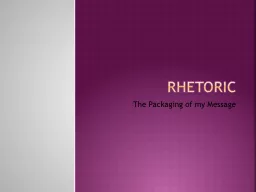

The Packaging of my Message Everyone and anyone can communicate Aristotle defined rhetoric as the faculty or skill of discovering the available means of persuasion in a given case It is an analytical skill ID: 267943
Download Presentation The PPT/PDF document "Rhetoric" is the property of its rightful owner. Permission is granted to download and print the materials on this web site for personal, non-commercial use only, and to display it on your personal computer provided you do not modify the materials and that you retain all copyright notices contained in the materials. By downloading content from our website, you accept the terms of this agreement.
Slide1
Rhetoric
The Packaging of my MessageSlide2
Everyone and anyone can communicate
Aristotle defined rhetoric as the faculty or skill of discovering the available means of persuasion in a given case.
It is an analytical skill. Slide3
Audience Analysis
Positive
Neutral
Disinterested
OpposedSlide4
Audience Analysis Strategies
Positive:
Narrative, Examples, Comparisons
Neutral
: Facts, Statistics, Testimony, Examples
Disinterested
: Facts, StatisticsOpposed: Narrative, Facts, Statistics, Examples, ComparisonsSlide5
3 primary Sources
Pathos
Ethos
LogosSlide6
Pathos
A listener’s personal needs, drives, and desires.
Pathos will determine the evidence and the delivery style you use.
Audiences will generally fall under four categories: positive, neutral, disinterested, opposed.Slide7
Maslow’s Hierarchy of Needs
Safety
Biological
Belonging
Esteem
Self-ActualizationSlide8
Key Words for Pathos
Appeal
Need
DesiresSlide9
Critique of Pathos
Facial Expression
Gestures
Voice
Platform MovementSlide10
Facials
Eye Contact
Brow
Panning the room
Smile
TensionSlide11
Gestures
Natural
Motivated by mood
Not overusedSlide12
Voice
Intelligibility=enunciate
Inflection=variation vs. Monotony
Tempo=characterization, mood, atmosphere
Volume=loudness
Force=intensity
Pitch=highness or lowness (habitual or ideal)Timbre=vocal qualitySlide13
Platforming
Posture
Movement
Body ToneSlide14
Ethos
The speaker’s character in the minds of the audience
.
Key Words:
Competence
Sincerity
Good willSlide15
Audience Analysis Strategies
Positive:
Narrative, Examples, Comparisons
Neutral
: Facts, Statistics, Testimony, Examples
Disinterested
: Facts, StatisticsOpposed: Narrative, Facts, Statistics, Examples, ComparisonsSlide16
Logos
The thinking process that allows the listener to arrive at logical conclusions
.
Key words:
Reasoning
EvidenceSlide17
Reasoning
The process of putting evidence together in a coherent argument to support a position:
Inductive: Specific to general
Deductive: General to Specific
Problem/Solution
Compare/ContrastSlide18
Reasoning
The process of putting evidence together in a coherent argument to support a position:
Inductive: Specific to general
Deductive: General to Specific
Problem/Solution
Compare/Contrast